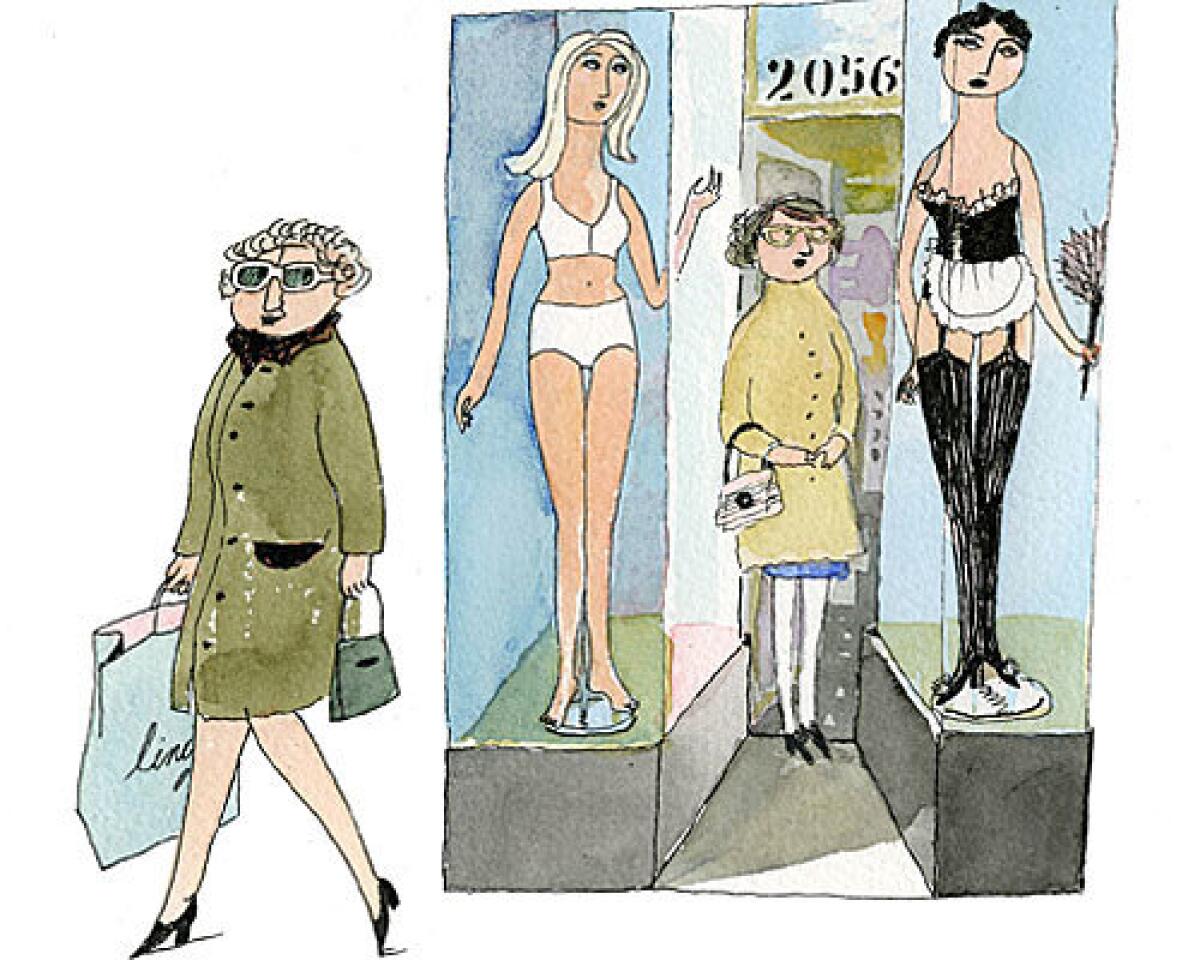Lingerie trends in bad times: simple or sexy

Sugar and spice -- or everything nice? It’s opposites that are propelling the lingerie market as the U.S. economy unravels and more Americans stay home. Whether it’s blasé basics or come-hither costumes, nesting is giving rise to dueling trends in the lace-trimmed world of intimate apparel. Comfort is paralleling escapism.
“It’s almost like the good girl and the bad girl,” said Rita Nakouzi, North American director of the fashion forecasting agency, Promostyl. “People are definitely [staying home] more, and what’s interesting is that it plays out in two ways. On the one hand, it’s about wanting things that are more second skin that make you feel cocooned. On the other, it becomes a little bit more naughty and about fantasy.”
Like so many other aspects of the American experience these days, today’s lingerie climate is taking at least some of its cues from the Depression. Back then, “If women had any money at all to spend on clothes, it was something to help the clothes look good on them,” said Jane Farrell-Beck, author of the book “Uplift: The Bra in America.” So, foundations, as they called them -- brassieres and girdles -- “those were the thing,” she said.
That trend toward sturdy foundations is mirrored in today’s fragile economic climate. Women still need something to cover their backsides and to keep the girls in place.
“If you can’t go out and buy a whole new wardrobe, you can at least have a good bra that makes you look good in the clothes you already have. A little treat in lingerie is less expensive than going out and buying a new outfit,” said Jen Abercrombie, owner of the Panty Raid boutique in Silver Lake.
“People aren’t taking as many chances,” she added. They’re sticking to the basics, and they want the ones that work.
Intimate apparel was one of the last retail segments to droop as the economy headed south last year. Though women’s sportswear began to falter last spring, the straps didn’t start slipping off the lingerie business until late fall. Unit sales in November were down from a year prior, but the dip didn’t approach Detroit-level lows, according to New York-based market research firm NPD Group. Sales had dropped 4%.
The “must-have” nature of intimates helped keep the news from being worse. Even in good economic times, need is the No. 1 reason women buy lingerie. It’s a lot more acceptable to wear last year’s outfit than it is to don a ratty bra. Especially these days, when straps are purposefully exposed for fashion, bits of dangly elastic and sagging, bagging fabric won’t fly. Yet bags and sags are inevitable. Underwear is perishable. Subject to intense use, there’s only so much an intimate garment can take before the elastic loses its snap or an underwire pokes its patron.
That was the sad state of affairs that brought Karen Salvador to the intimate apparel department of a Pasadena Macy’s on a recent Monday. The 28-year-old physical therapist was tired of hitching up the worn-out strap on the bra she bought from Target just six months earlier. Describing her financial situation as “so-so,” Salvador doesn’t ordinarily shop at Macy’s, she said. But she’s trying to save money in the long run by spending a little bit more on a better-quality brand up front.
Perusing the racks of plain beige separates from Calvin Klein, Maidenform and Warner, Salvador said, “Maybe I can use it for a longer period of time instead of just buying those cheapie bras that will wear out and then I need to buy one again. I would rather go to a thrift store, but I’m looking for a bra that I can use for a long time.”
“Replenishment” is the F cup of lingerie market segments. It’s the biggest reason for sales. “Technology” (undergarments that shape bodies and form the surgery-free illusions of more or less) and “fantasy” (highly sexualized items that provide escapism through role play) are smaller pieces of the pie. But of those smaller pieces, fantasy is the one that’s selling.
“In times where everything is expensive -- entertainment, going out to dinner -- rediscovering the joys of the bedroom for much less money comes into play,” said Joelle Saxon, owner of Mrs. Jones Boudoir in Camarillo. At Saxon’s boutique, garter belts, bustiers and other “very feminine, risqué things that spark the imagination” are doing well, she said.
At Trashy Lingerie, it’s bedroom costumes. Walk past the pink-trimmed, plate-glass windows of this appropriately named WestHollywood shop, and the interior is a titillating emporium of silky thongs, leather-trimmed corsets and Lucite heels, but it’s the skimpy, sexually charged maid, nurse and schoolgirl uniforms that are the “classics” at this members-only boutique.
“We sell that every day, all day long,” quipped a shopkeeper on a recent Sunday, referring to the bevy of low-cut tie tops and panty-skimming micro minis that put the “tart” in tartan.
“Lingerie, I feel like it’s the best way to spice things up,” said Daniel Volz, 23, who was shopping at Trashy with his girlfriend over the weekend.
“I love looking at it. She loves wearing it. It’s a match made in heaven,” he said before being summoned to a velvet-curtained dressing room where his petite blond girlfriend Keri had transformed herself from T-shirt-wearing everywoman to super-vixen. As she twirled in front of the mirror, showing off her enviably lithe figure in a black and pink garter skirt with matching push-up bra and platforms, Volz enthused: “Do you see why I like lingerie so much?”
Sex will always sell -- even in a down economy. When it’s packaged as a pair of frilly lace panties trimmed with satiny pink ribbon, it’s just selling slightly less than it had a year earlier. “Lingerie is one of the most passionate consumer purchases, but it is not invincible in this economic downturn,” said Marshal Cohen, senior analyst for the NPD Group. Still, it’s one of the last categories consumers stop buying, and “it will most likely be one of the first to return,” he added.
“If I was looking at the economy from the government’s perspective, I wouldn’t look at the auto or house industries. I would be looking at intimate apparel, because that will clearly show me when the consumer is saying: ‘I don’t want to feel lousy anymore. No, I don’t have more money. But I need to feel good again.’ ”
More to Read
Sign up for our L.A. Times Plants newsletter
At the start of each month, get a roundup of upcoming plant-related activities and events in Southern California, along with links to tips and articles you may have missed.
You may occasionally receive promotional content from the Los Angeles Times.






